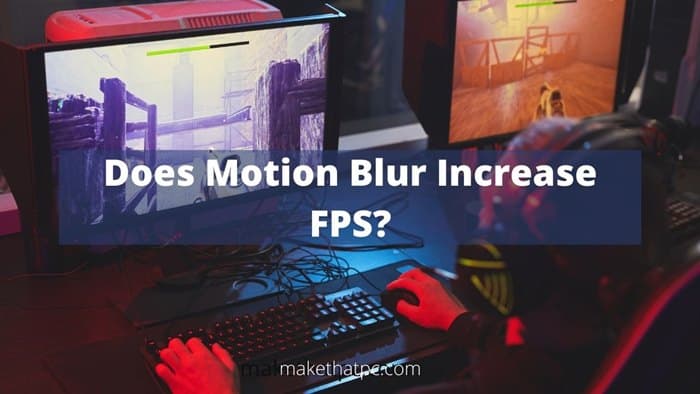Have you ever noticed how your eyes only focus on one object while you’re peeping out through your car window and everything else just seems to blur away? It is known as natural motion blur. In simpler terms, motion blur is adapted by the human eye to eliminate excessive stress. If we had to focus on everything that is noticeable in the visible frame, we would have experienced headaches every time we looked out of our car window.
This scenario is closely applicable to modern-day video games. In fast-paced games such as GTA V and Call of Duty, where you have a moving subject and various components on the screen at the same time, motion blur plays a vital role in maintaining the fluidity of the game. As a result, it makes our in-game experience a lot smoother.
So, there is no direct impact of motion blur of FPS. It doesn’t increase the FPS. But, it will make the low FPS look more appealing. In other words, for those who hate playing on low FPS but have to do it somehow, motion blur can make it easily bearable. Let’s talk some more about whether motion blur increases FPS or not.

But what is a motion blur in games?
For the record, motion blur is a visual aesthetic added to motioned objects in graphic-intensive games. It helps to maintain a rich in-game experience and aids gamers to focus on what’s most important within the game frame.
Motion blur is turned on by default on most games of today. In the case of cameras and videos, motion blur tends to add a cinematic effect, making it more life-like. On the flip side, it has a completely different utility when it comes to games. It comes in handy when you have to focus on one object in-game. (Say we have to focus on an enemy in games like Call of Duty).
To put it simply, all that motion does is it blurs away the extra elements in the frame, leaving you to focus on what’s more important. But in cases of games that run at high speed, motion blur does not help much because here we are focusing on the overall experience. Added to that, most gamers find it annoying when the motion blur is on, as it makes the game less immersive and more faded.
How motion blur is related to FPS?
To understand this, we first need to be clear on what FPS is all about.
The acronym FPS, aka Frames Per Second is pretty straightforward stuff. The name itself suggests that it is the number of frames displayed in one second. The higher the rate of FPS, the smoother will be the visuals. Fun fact, our eyes can only catch about 50-60fps. Even in cases of cinemas or YouTube videos, it is seen that the FPS affects the quality of the image or videos significantly.
However, games have a different drill. Consider this instance for a better understanding: Say a game runs at 30 fps. So, the game is updating the display at 30 frames in a second, which makes the objects in-game look a lot more choppy, which is better known as frame Lag. So, here motion blur can be used to fill those lags and make the game appear smoother.
But if the same game runs at 120fps, we can say it refreshes around 120 frames in a second, giving you a better gaming experience. It allows us to see what is happening in the game in real-time because even a fluctuation in a fraction of a second can make you lose against your enemy. Here, you will have no need to add motion blur because you can’t even observe it is there.
All in all, almost all gamers tend to prefer higher fps to leave no stones unturned towards a smoothing gaming endeavor.
How is FPS related to Motion blur?
Now that we have an idea about motion blur and FPS, let’s see why it is a much-discussed topic. Motion blur and FPS is co-related in the truest sense of the term, but not exactly inter-dependent. There is a fine line of difference between the two above-mentioned functionalities.
FPS solely depends on the graphics card you are using and the VRAM backing up. Motion blur just adds a visual effect over the FPS. It minimizes the rough cut-through transition between the frames and mixes the ends of those frames to give you a smooth visual as an end-product instead of choppy frames. Owing to that, it may integrate and mix the ends of the frame, but does not really alter the rates of frames in a second.
Though in some games, motion blur may affect the way we perceive the FPS, and we end up blaming or hating the motion blur functionality. Well, in reality, it is just that the in-game graphics is not able to tackle the changes at 120fps. As it is graphic intensive, your system tries to compromise by doing 119 (instead of 120) changes to make it seem everything’s alright. As the compromise is extremely minimal, still, it is omnipresent in almost all high-end games of today.
Does the motion blur effect lag in a game?
In-game lags can be best defined as the number of frames dropped and missed here and there in one second. This truly affects the gaming experience and is very evident to our naked eyes. Also, you may experience game lags due to low ping and inconsistent network connection too.
Ping is usually referred to as latency, which is a delay between what intend to do with your in-game character vs exactly what the character does but sometime later. When you play games at max settings, you’re more likely to experience the same.
Do note that Motion blur is not the culprit here, as it does not really do much to affect latency. However, it aids us in smooth sailing throughout our gaming sessions.
Lastly, the rest lies in the in-game experience. If you are experiencing a better gaming escapade, leave the motion blur settings turned on. On the flip side, if you feel that it is adding up to the high latency issues, you may sniff it off.
Wrapping Up
To summarize everything that we’ve discussed so far, motion blur does not have any noticeable impact on the FPS. With that said, it certainly does mix frames to give a hassle-free gaming experience, which may trick your mind into thinking that it is affecting the FPS.
On the other hand, in some games, it is evident that motion blur alters the FPS a little bit, just to add the effect properly. That’s all you need to know!

I am Anshul Rana, an experienced author specializing in PC gear reviews and Windows 10 software tutorials. With a strong passion for technology and an in-depth understanding of the PC industry, I provide insightful and detailed analyses of computer peripherals, gaming gear, and software solutions. My writing style is concise yet informative, making complex topics accessible to both beginners and advanced users. Through my reviews and tutorials, I aim to offer valuable guidance, helping readers make informed decisions to enhance their PC experience and explore the vast possibilities of Windows 10 software.









